Light, loud, strong – RAM Audio “Zetta Z-236” and Z-440 power amps – Product review from tools4music
At the very beginning of my work for tools 4 music in 2008 I had a RAM Audio S-4044 on my workbench whose structure and stability at that time impressed me. In the following years, I used two devices of this 4-channel power amp in regular live operation under varying operating conditions. The S-4044 had an interesting design concept with reliable circuit design and is still available today. With the “Zetta” series, now available from Adam Hall, RAM Audio introduces a new power amp family, whose main characteristics are a low purchase price, suitable performance and 2-ohm stability.
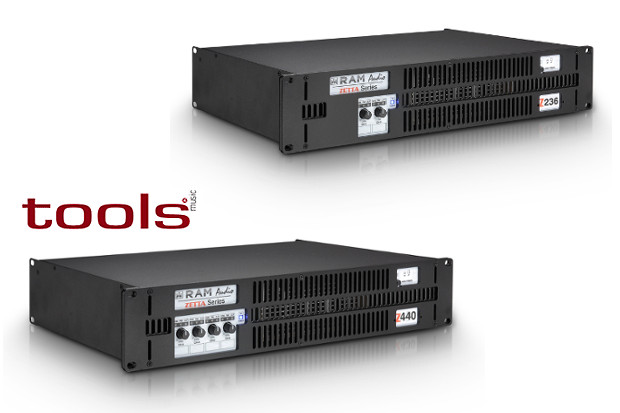
RAM Audio from Valencia in Spain is known for reliable power amps with minimal weight and installation depth. The new “Zetta” series consists of seven models in 2- and 4-channel models with capacities of up to 2 x 1,800 watts and 4 x 1,000 watts.
The concept is based on proven Class H circuit audio power amplifiers and “QuantaPulse” power supply technology. The weight is only 6.5 kg with a housing height of two rack units (88 mm) and a depth of just 25 cm. All models are based on a similar housing design and are equipped with Neutrik XLR and Speakon fittings, with permanently attached power cord.
The cooling system is based on a temperature-controlled 88 mm fan and works from back to front without dust filter (why doesn’t anyone actually build in dust filters any more, the editors wonder). The manufacturer uses an upside-down design to prevent dust and dirt build-up. The “upside-down” refers to the design of the electronics where the heat sinks are built on the bottom. The advantage of having top-mounted circuit boards is easy to understand: Dust always accumulates on the bottom, thus preventing heat build-up in the delicate SMD components around the heat sinks of the output transistors.
Figures 1 and 2 show the opened test models “Zetta 236” (2-channel amplifier) and “Zetta 440” (4-channel amplifier). Due to the inverted mounting of the circuit boards, the Speakon output connectors are upside-down, proving a bit weird to handle in terms of latching.


Depending on the model, the steel housing is without installation handles and fitted with corresponding foil decal on the back, and unused outputs are simply sealed over with adhesive. Controls on the back are limited to recessed slide switches for the optional bridge mode operation of outputs. For use with these, the Neutrik Speakon connectors are shaded according to one of 4 pins.
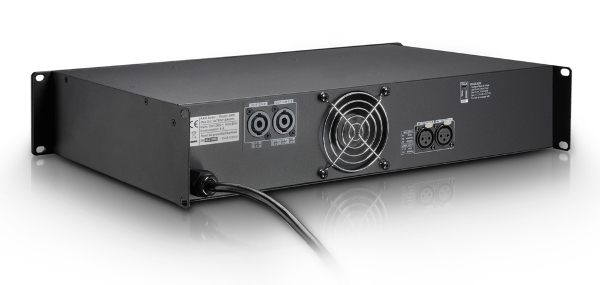
The XLR version input sockets without forwarding option — also from Neutrik — round out the connection options. The front panel controls on the sample RAM Audio “Zetta Z-440” consist of resting level controls for sensitivity adjustment, an LED display for signal level (SGNL), a Power Management System (PMS) and a clip indicator for when the ICL limiter (lmproved Intelligent Clip Limiting) is in operation. The signal level LEDs indicate the presence of input signals even from closed controls – a useful feature when there are problems in the signal path of a sound system.
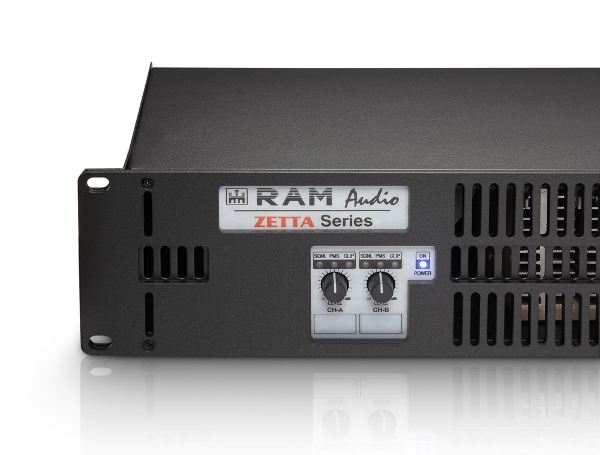
Cover removed
The engineering of both power amplifiers is based on a central circuit board for power supply and audio electronics. The mains voltage is fed to the switching power supply through a capped fuse and a passive input filter. The power switch obviously releases the mains voltage directly to the power electronics without the use of an additional relay. Nothing wrong with that, provided the switch model used is scaled to the electricity requirements for power electronics.
An active power factor correction is not provided, as can be seen in measurement of the power voltage input current in Figure 5. If the current corresponding to the black curve comes in pulse packets, the power supply capacitors are easily recharged in a 50Hz pulse sequence. The blue curve shows the output of a power amplifier channel, which emitted a frequency of 100Hz with 83V at 8 ohms in our test. The four capacitors of the mains voltage side in the power supply are 85° types, which are mounted directly next to the heat sinks of the power supply switching transistors and rectifiers.
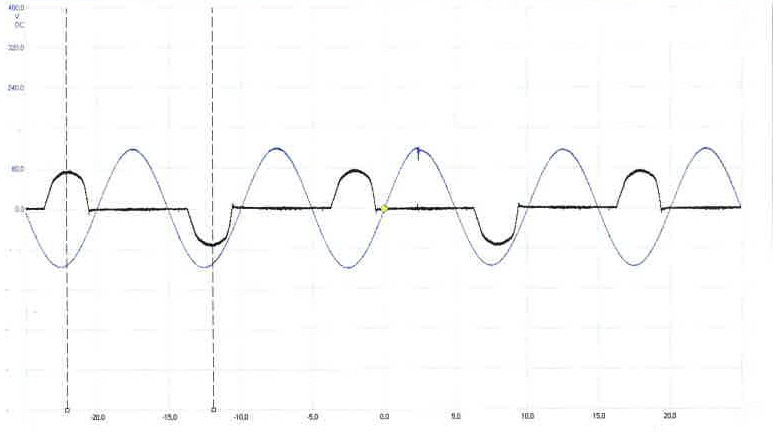
Because of the resulting heat output from their direct vicinity, 105° types would be more suitable here. The power supply provides the operating voltages for power electronics in two voltage levels corresponding to the Class H circuit design. In our test models, we measured the 2-channel amplifier Z-236 at a lower voltage of 69V, and the switching at the high operating voltage of 140V.
In the 4-channel variant, Z-440, there are slightly lower voltage levels. Here I measured 54 and 110V. To buffer the audio supply voltage, there are are twelve capacitors at the rear directly in front of the Speakon connectors. All capacitors are carefully secured with adhesive. We backed up the supply voltage of the pre amps using linear voltage regulators configured at 15V. The complete driver circuit is manufactured in the SMD version typical to RAM Audio. Since this part is built in at the top of the power amp, water and accumulated dust are largely a non-issue for the filigreed platinum circuit board.
Production in SMD technology has become the industry standard. However, it should be mentioned that in case of any errors to the power amp or power supply electronics, the circuit board can be affected by scorch marks that will make repair basically impossible or prohibitively expensive. Looking to the future, this would inevitably be tantamount to consigning it to the electronics scrapheap, since repair shops not specialising in this technology won’t be able to really save you anything in terms of cost ceilings.
Signal test
Power measurements aren’t exactly as exciting as a thriller novel, but have a certain charm (for the technician, the editors), because you never know whether the subject will be able to handle the stress tests unharmed. First I checked the background noise (Figure 6) of the audio electronics. In open level controls we got a nice low -72.7dB (A) – super!
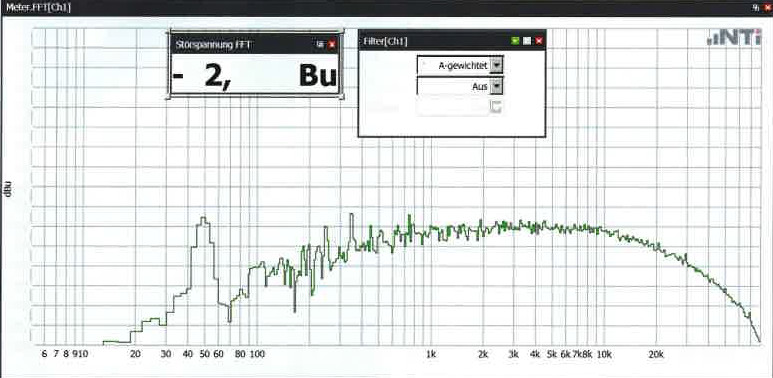
The THD measurement of the sample Z-440 in Figure 7, at a frequency of 1 kHz and 1 watt at 8 ohms, shows almost only unlevel distortion. This property is also confirmed at higher modulation with 312 watts at 8 ohms in Figure 8, wherein the total result of all distortion elements can be rated as very good, with a THD of only 0.062%.
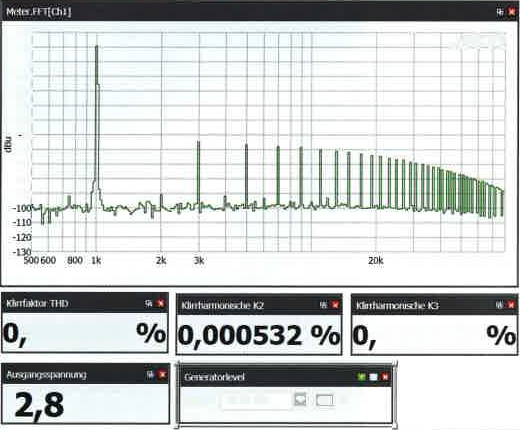
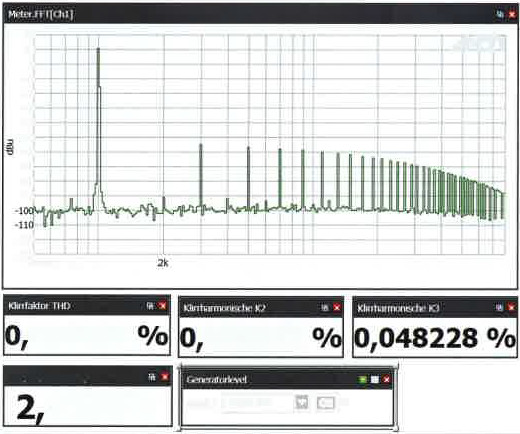
Figure 9 presents the frequency response with a frequency range between 10Hz and 20kHz (-3dB), while showing the harmonic distortion based on the frequency.
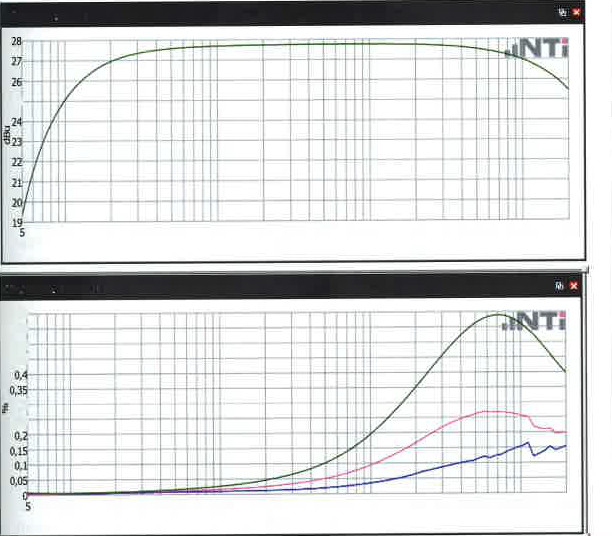
The increase in the THD at 20 volts’ output at higher frequencies, for example, is normal. Something more interesting is the distortion’s dependence on the load impedance.
The distortion path for 8 ohms (45 watts) is shown in blue; pink shows 4 ohms (90 watts) and green, the behaviour at 2 ohms (180 watts).
For further analysis of the power amp features, the signal quality of the square frequencies fed in (Figure 10) are checked at 1 kHz, for example. Here, green is the signal generator and blue the output voltage at 8-ohm load resistance. The asymmetric waveform with 30 volts positive and 20 volts negative half-wave is striking.
So, while I can’t really come up with a proper explanation for it, I suspect it’s a reaction to the ever vigilant ICL limiters to a waveform that is so unlike one from an audio amplifier.
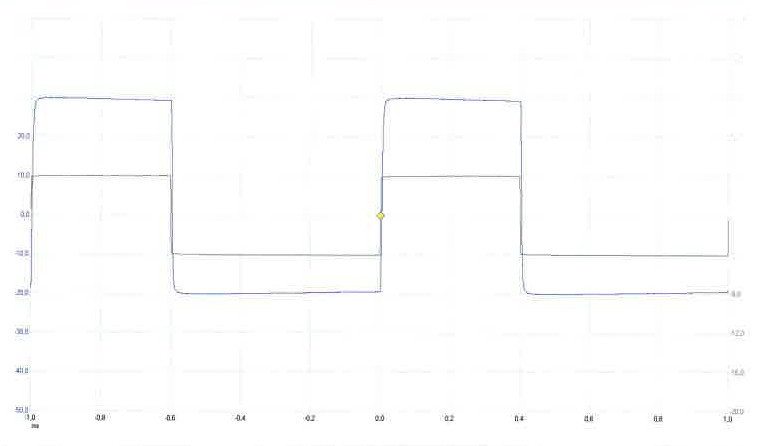
To measure the output voltage of a power amplifier, we use burst signals at 60 and 1,000Hz frequencies. The signal duration for 60Hz was 100ms; for l,000Hz only 20ms. The power was recorded at 60 Hz within the first 33ms and at 1,000Hz within 10ms. During the measurements, both channels were loaded, so that the power supply was used to capacity.
The mains voltage on our test station is 235V and has a 32 amp fuse, which, of course, according to the applicable VDE standard for devices with a safety plug, is not allowed. The high fuse protection in the laboratory allows full control of the power consumption from the grid, which in many modern power amp systems the impulse range clearly exceeds the standard 16-amp fuse protection. With our 32-ampere protection, we are thus “unimpeded” in our observation of the power management of a power amp under load, without fear of the mains voltage switching off due to exceeding the 16-amp fuse tolerance.
The assessment of the power consumption was performed conventionally with an analogue ammeter and high-precision 60-ampere-sense resistor in series with the test object. (In a future tools-4-music-issue, I will give a tour of the measurement technique, and explain the technical contexts and backgrounds in depth.)
But back to the RAM Audio “Zetta” test series, where the 2-channel Z-236 opened the power test. In Figure 11, the output signal of a 20-ms burst signal is seen at 1kHz. The vertical dashed lines are the 10ms measurement section in which the Analyser software calculates the voltage value (RMS). In the picture, these are 78.5 volts for channel A, and, 80.5 volts for channel B. It becomes clear here that channel A had already produced slight noise in the upper half-waves, which are displayed in the top right corner of the zoomed image.
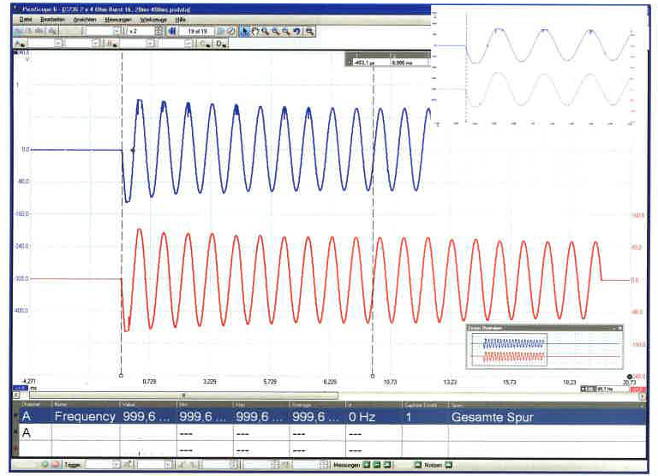
In terms of output power at 2 x 4 ohm load, the RAM Audio Z-236 reaches 1,540 watts on channel A, and 1,620 watts on channel B. The variance between this and the manufacturer’s stated 1,800 watts per channel is due to the not quite 240 volt mains voltage magnitude in our laboratory and the voltage drop of 230 volts under load condition caused by the power consumption. In a control measurement in Figure 12 at 240-volt mains voltage (thanks to an adjustable 2,000-watt transformer), the power amp reached an 85 volts RMS output voltage at 4 ohms, which then corresponds exactly to 1,800 watts.
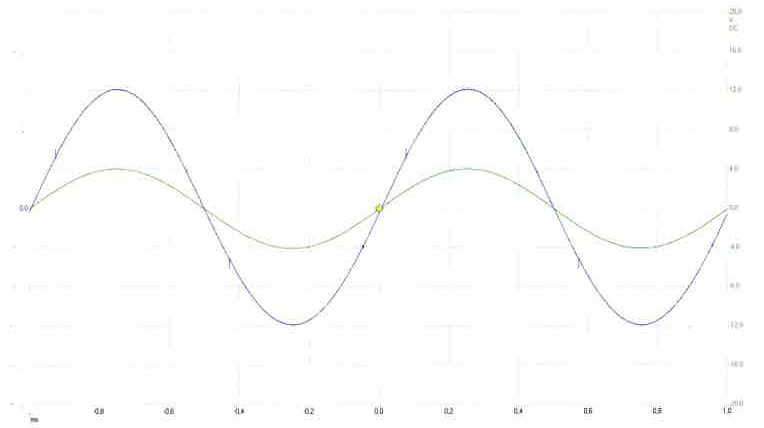
The measurement shows another curve in green, showing the input signal of 2.8 volts (11dBu) needed for full modulation. The ICL limiter effectively prevents overload of the power amplifier channels, which means that an increase to the input voltage is no problem. Interestingly, the signal peaks are on rising and falling signal amplitude, caused by the switching of the operating voltage level of the Class H principle, which in this case is not executed entirely cleanly.
On the power measurement station, the test equipment displayed very high-functioning power management in the power supply, which after a short time reduces the initial power pulses of nearly 30 amp to values compatible with 16-amp fuses. Figure 13 shows how the power consumption from the grid (shown in black) together with the output power is limited after about 9 seconds. In order to show the control functions of the audio RAM “Zetta” series in this form, I extended the 60-Hz pulses to 1 second and at the same time reduced the dead time to only 100ms. Pure stress for the power amp and for me too, since in such experiments there’s also the risk of unintentional “table fireworks” when testing – but fire extinguishers and smoke ventilators were left untouched.
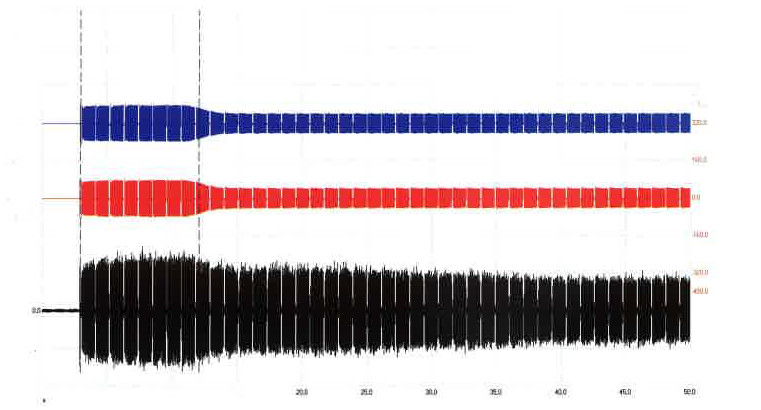
The power indications from the manufacturer RAM Audio are therefore based on reasonable information that can be achieved with a mains voltage of 240 volts.
We did not identify any temperature issues. The “Zetta” series responded to the short-circuit test with a flashing ICL LED upon simultaneously greatly increasing power consumption. A common behaviour, since the electronic power limiting is prompted in the amplifier channels over very low Ohm resistors close to the power transistors. This results in a balance between maximum permissible short-circuit power and corresponding short-circuit voltage. RAM Audio calls its electronic power limiting “SSP Protection” and it works on each channel individually so that the unaffected channels can continue to operate.
Finally, a word on the term “damping factor” that always “pops up” in discussions on the topic of power amplifiers and speakers. In this case, the damping factor is really nothing more than the ratio of the internal resistance of a voltage source (in this case, the output of the power amplifier) and a connected load impedance.
Unfortunately, in lots of technical specifications on the damping factor, the value of the underlying measurement voltage is omitted, leaving its validity in doubt. The info box gives a quick glimpse into the calculation ability and backgrounds of the damping factor. The RAM Audio “Zetta” power amplifiers have a a DF of 427 with 30V metering voltage at 1-kHz measuring frequency. RAM Audio specifies the damping factor of over 500 at 8 ohms between 20 and 500 Hz.
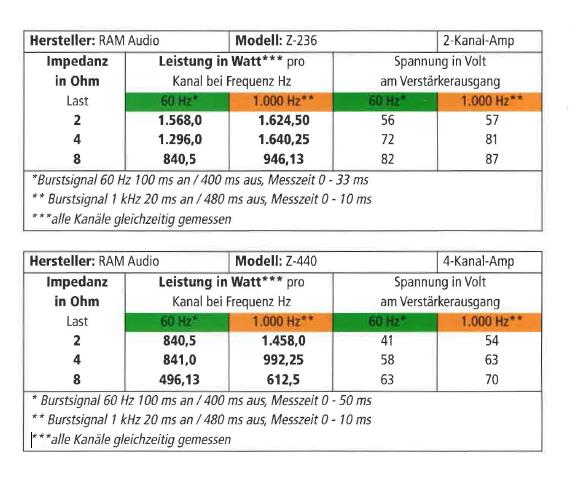
Drum roll
With the “Zetta” series from the Spanish manufacturer RAM Audio, Adam Hall’s sales department is appealing to professional users, where the power amps’ favourable cost, light weight and space-saving dimensions are more important than convenient configuration features. The power amplifiers provide all the essential functions and hit the mark with their sound circuit design, combined with good processing quality.
Body and housing within the seven models in this series are almost identical and allow for installation or touring racks with compact dimensions and low weight. A feature of the “Zetta” power amplifiers is the possibility of operating speaker impedances from 2 ohms, which, in combination with the power management of the power supplies, neither causes an overload on the amplifier electronics nor on the power supply. The power amplifiers do not have dust filters – something I wished they did.
Price-wise, the RAM Audio “Zetta” power amplifiers cover a comparatively moderate terrain. Thus, the list price for the Z-236 2-channel power amplifier is €1,099, and for the Z-440 4-channel model, €1,349. In terms of the professional construction and lightweight design attractive to many, the series is quite worth considering.
Demand
Viktor Wiesner, Product Manager at Adam Hall, from German RAM Audio Sales:
“Known for its extremely powerful and reliable amplifiers, the Spanish manufacturer RAM Audio from Valencia now introduces a new series of seven models in 2- and 4-channel versions. The highly efficient Class-H design of the “Zetta” series offers absolutely professional features for demanding installation and touring applications. At only 2 RU and 25 cm depth, the mechanically extremely robustly constructed, but only 6.5 kg-light “Zetta” power amplifiers deliver up to 2 x 1,800 and 4 x 1,000 watts, where the “QuantaPulse” switching power supply ensures a perfectly controlled power supply.
The upside-down design with generously dimensioned components prevents the accumulation of dust, while the particularly effective rear-to-front cooling system with solid heat sinks made of aluminium and temperature-controlled fan prevents overheating. The “Zetta” series offers comprehensive protection systems for the amplifier section and the power supply. The “Zetta” power amplifiers are equipped with XLR and Speakon connectors by Neutrik at the audio input and speaker jacks. Sealed rest potentiometers allow precise adjustment of the volume. With the new series, RAM Audio presents an attractive amplification solution that impresses not least of all by its economical pricing.”
Pros & Cons
+ low mounting depth
+ weight
+ cheaper purchase price
+ high output powers from 2 ohms
+ protection circuits
+ processing
+ resale value
– high repair costs in the case of service due to SMD technology
– no dust protection
Facts
Sales: Adam Hall
List price:
RAM “Zetta Z-236”: €1,099
RAM Audio “Zetta Z-440”: €1,349
________________________________________
Source: tools4music Magazine, 6/2014: http://www.tools4music.de/
Author: Stefan Kosmalla
Here you will find all the information on the RAM Audio “Zetta” series:
http://www.adamhall.com/en/RAM_Audio_Zetta_series.htm
Leave a Comment
You must be logged in to post a comment.











